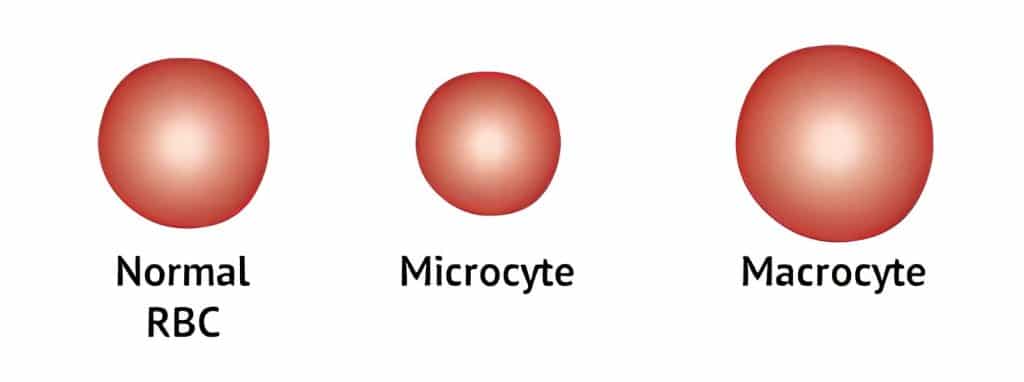What is Macrocytic Anemia?
Macrocytic anemia is a type of anemia in which red blood cells are bigger than usual. Anemia is a condition in which the blood lacks sufficient healthy red blood cells to transport oxygen to the tissues. Red blood cells are made in the bone marrow and remain viable for about 120 days. The spleen and liver remove them when they get old or damaged.

Macrocytic anemia can be caused by a variety of reasons, including a lack of vitamin B12 or folate, alcoholism, liver disease, hypothyroidism, certain drugs, or bone marrow problems. Idiopathic macrocytic anemia occurs when a person develops macrocytic anemia for no obvious reason.
Macrocytic Anemia ICD 10 Code
The ICD 10 code for macrocytic anemia is D53.9, which stands for nutritional anemia, undefined. This code covers all kinds of macrocytic anemia that are not else classified in the ICD 10 system. Other codes for specific kinds of macrocytic anemia may be used:
D53.1: Other megaloblastic anemias not defined elsewhere: This code applies to macrocytic anemias produced by decreased DNA synthesis in the bone marrow, such as those induced by a lack of vitamin B12 or folate, toxins, or medications.
D64.9: Unspecified anemia: This code applies to any type of anemia that is not covered by another code.
(Read About Deadly Marburg Virus Outbreak in Africa 2023)
Signs and Symptoms of Macrocytic Anemia
The signs and symptoms of macrocytic anemia may vary depending on the severity and the underlying cause. Some common signs and symptoms include:
- Fatigue
- Weakness
- Pale skin
- Shortness of breath
- Dizziness
- Headache
- Chest pain
- Irregular heartbeat
- Numbness or tingling in the hands or feet
- Cognitive problems
- Glossitis (inflamed tongue)
- Jaundice (yellowing of the skin or eyes)
Diagnosis of Macrocytic Anemia
The diagnosis of macrocytic anemia is based on a complete blood count (CBC) test, which measures the number and size of red blood cells, as well as other blood components. A CBC test can show a low hemoglobin level (the protein that carries oxygen in red blood cells), a low hematocrit level (the percentage of red blood cells in the blood), and a high mean corpuscular volume (MCV) level (the average size of red blood cells). An MCV level above 100 fL is considered macrocytic.
Other tests that may be done to determine the cause of macrocytic anemia include:
- Vitamin B12 and folate levels
- Liver function tests
- Thyroid function tests
- Bone marrow biopsy
- Genetic tests
Treatment for Macrycytic Anemia
The treatment of macrocytic anemia depends on the cause and the severity of the condition. Some possible treatments include:
- Vitamin B12 or folate supplements or injections
- Dietary changes to increase intake of foods rich in vitamin B12 or folates, such as meat, eggs, dairy products, green leafy vegetables, beans, nuts, and fortified cereals
- Alcohol cessation or moderation
- Medication adjustment or discontinuation
- Treatment of underlying conditions, such as liver disease, hypothyroidism, or bone marrow disorders
- Blood transfusion or erythropoietin therapy for severe cases
Prevention of Macrocytic Anemia
The prevention of macrocytic anemia may involve:
- Eating a well-balanced diet high in vitamin B12 and folate
- Taking vitamin supplements as prescribed by your doctor Limiting your alcohol consumption
- Following your doctor’s recommendations for drug use and monitoring
- Regular examinations and blood testing to detect any indications of anemia
Microcytic Anemia Vs Macrocytic Anemia
| Microcytic Anemia | Macrocytic Anemia |
|---|---|
| Red blood cells are smaller than normal (MCV < 80 fL) | Red blood cells are larger than normal (MCV > 100 fL) |
| Usually caused by iron deficiency or inherited disorders | Usually caused by vitamin B12 or folate deficiency or megaloblastic anemia |
| Common signs and symptoms include fatigue, weakness, pale skin, pica, spoon-shaped nails, and angular cheilitis | Common signs and symptoms include fatigue, weakness, pale skin, shortness of breath, dizziness, headache, glossitis, and jaundice |
| Diagnosed by CBC test, iron studies, peripheral blood smear examination, hemoglobin electrophoresis test, and bone marrow biopsy test | Diagnosed by CBC test, vitamin B12 and folate levels, peripheral blood smear examination, bone marrow biopsy test, and genetic tests |
| Treated by iron supplements or injections, dietary changes, blood transfusion, or medication adjustment | Treated by vitamin B12 or folate supplements or injections, dietary changes, blood transfusion, erythropoietin therapy, or medication adjustment |
FAQs
Q: What is microcytic anemia?
A: Microcytic anemia is a type of anemia that occurs when the red blood cells are smaller than normal. Anemia is a condition in which the blood does not have enough healthy red blood cells to carry oxygen to the tissues. Red blood cells are produced in the bone marrow and have a lifespan of about 120 days. When they are old or damaged, they are removed by the spleen and liver.
Q: What is the ICD 10 code for microcytic anemia?
A: The ICD 10 code for microcytic anemia is D50.9, which stands for iron deficiency anemia, unspecified. This code covers all types of microcytic anemia that are caused by low iron intake, inefficient iron absorption in the gastrointestinal tract, or chronic blood loss. Other codes that may be used for specific types of microcytic anemia include:
D50.0: Iron deficiency anemia secondary to blood loss (chronic): This code covers microcytic anemia that is caused by long-term or repeated bleeding, such as ulcers, tumors, or menstrual disorders.
D50.1: Sideropenic dysphagia: This code covers microcytic anemia that is caused by a rare condition called Plummer-Vinson syndrome, which involves difficulty swallowing due to esophageal webs and iron deficiency.
D50.8: Other iron deficiency anemias: This code covers microcytic anemias that are caused by other factors that affect iron metabolism, such as infections, inflammation, or malignancy.
Q: What are the causes of microcytic anemia?
A: Microcytic anemia can be caused by various factors that reduce the amount or availability of iron in the body, such as:
Poor dietary intake of iron-rich foods, such as meat, eggs, seafood, beans, nuts, and green leafy vegetables
Malabsorption of iron due to gastrointestinal disorders, such as celiac disease, Crohn’s disease, or gastric bypass surgery
Increased demand for iron due to pregnancy, lactation, growth, or exercise
Chronic blood loss due to menstruation, peptic ulcer, hemorrhoids, colon polyps, colon cancer, or other sources of bleeding
Inherited disorders that affect red blood cell production or function, such as thalassemia or sideroblastic anemia
Q: What are the signs and symptoms of microcytic anemia?
A: The signs and symptoms of microcytic anemia may vary depending on the severity and the underlying cause. Some common signs and symptoms include:
- Fatigue
- Weakness
- Pale skin
- Shortness of breath
- Dizziness
- Headache
- Chest pain
- Irregular heartbeat
- Pica (craving for non-food substances, such as ice, dirt, or clay)
- Spoon-shaped nails (koilonychia)
- Angular cheilitis (cracks at the corners of the mouth)
Q: How is microcytic anemia diagnosed?
A: The diagnosis of microcytic anemia is based on a complete blood count (CBC) test, which measures the number and size of red blood cells, as well as other blood components. A CBC test can show a low hemoglobin level (the protein that carries oxygen in red blood cells), a low hematocrit level (the percentage of red blood cells in the blood), and a low mean corpuscular volume (MCV) level (the average size of red blood cells). An MCV level below 80 fL is considered microcytic.
Other tests that may be done to determine the cause of microcytic anemia include:
Iron studies, such as serum iron level, serum ferritin level (a measure of iron stores), total iron binding capacity (TIBC) level (a measure of iron transport), and transferrin saturation level (a measure of iron availability)
Peripheral blood smear examination, which involves looking at a drop of blood under a microscope to check for abnormal shapes or sizes of red blood cells
Hemoglobin electrophoresis test, which involves separating different types of hemoglobin molecules using an electric current to check for inherited disorders such as thalassemia
Bone marrow biopsy test, which involves taking a small sample of bone marrow tissue from the hip or chest bone to check for
References
- Search Page 1/8: macrocytic anemia – ICD10Data.com. https://www.icd10data.com/search?s=macrocytic%20anemia
2. 2023 ICD-10-CM Diagnosis Code D53.9 – ICD10Data.com. https://www.icd10data.com/ICD10CM/Codes/D50-D89/D50-D53/D53-/D53.9
3. 2023 ICD-10-CM Diagnosis Code D53.1 – ICD10Data.com. https://www.icd10data.com/ICD10CM/Codes/D50-D89/D50-D53/D53-/D53.1
4. 2023 ICD-10-CM Diagnosis Code D64.9: Anemia, unspecified. https://www.icd10data.com/ICD10CM/Codes/D50-D89/D60-D64/D64-/D64.9
You May Also Like
- Premenstrual Syndrome (PMS) Explained: Powerful Relief Strategies for 2026
- Magnetic Seizure Therapy (MST): A Breakthrough in Psychiatric Treatment in 2025
- AIIMS New Delhi, NIMHANS Bengaluru, JIPMER Puducherry: No Leaves for Healthcare Workers Amid Tensions
- Narcissistic Personality Disorder in 2025: Unveiling the Hidden Struggles and Empowering Recovery
- Conquering Rubral Tremor: Unveiling Effective Treatments in 2025
